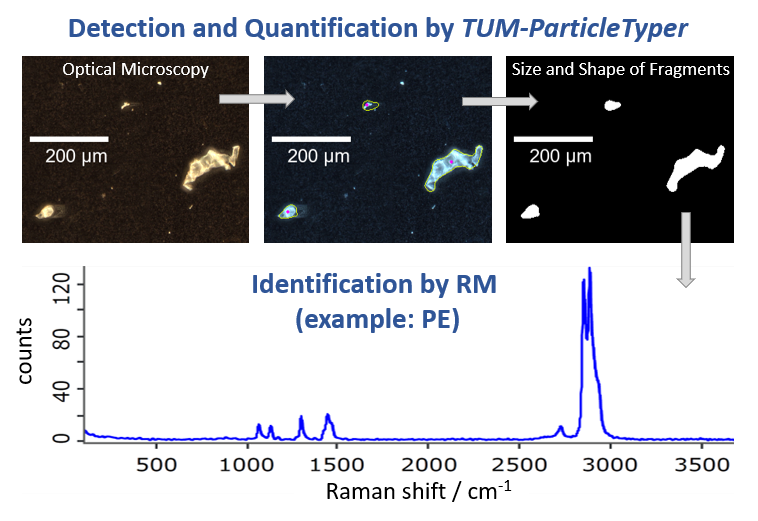Horizontal and Vertical Oceanic Distribution, Transport, and Impact of Microplastics / HOTMIC
Objectives
- Optimization, further development and application of Raman microspectroscopy (RM) for the detection,
identification and quantification of small microplastic (MP) particles - Development, validation and testing of an automated Raman-based method for the analysis of MP
particles smaller than 10 μm and microfibers - Extension of RM applicability to 2D and 3D imaging of MP in biota samples, including particles smaller
than 10 μm - Intercomparison of methods for the analysis of MP in the entire size range (1 μm–5 mm) in different
environmental samples (incl. water, sediment and biota samples). Focus: Detection, identification,
quantification and characterization of MP by RM
Methods of Approach
- Raman Microspectroscopy (RM)
- Image analysis employing TUM-ParticleTyper
Description
The fabrication and use of plastic is essential to ensure an upscale standard of living. Due to its properties the fragmentation of plastic waste caused by physical strain and UV irradiation results in persistent plastic fragments (a fraction of which in a size range between 1 µm and 1 mm is called microplastics (MP) and a fraction between 1 mm and 5 mm - large MP). The accumulation of these fragments, especially in the marine environment, entails incalculable ecologic consequences.
The HOTMIC project (horizontal and vertical oceanic distribution, transport, and impact of microplastics) takes up the unanswered question about the remains of 90% of the plastic waste entering the marine environment. The distribution of plastic fragments in the ocean between coastal regions, open water, and oceanic gyres on the one hand, surface water, deep water, and sediments on the other, must be explored. For monitoring the magnitude of MP and its flux rates between coast and the (deep) sea, comprehensive sampling at different water depths and spots is needed. The analyses of these samples as well as sediment or biota samples include the identification and quantification of MP (≥ 1 µm) regarding size, shape, and material of individual microplastic particles and fibers. Further research topics are effects of weathering, predominant mechanisms of weathering, and biological effects on microplastics, e.g. biofouling, bioshredding or uptake of MP by biota.
Regarding the analytical part associated with the Institute of Hydrochemistry (IWC), Chair of Analytical Chemistry and Water Chemistry, focus will be on development and validation of a method based on Raman microspectroscopy (RM) in combination with particle detection employing TUM-ParticleTyper, that covers the lower MP size range between 1 µm and 10 µm. Additionally, a 2D- and 3D-imaging of MP (down to a size of 1 µm) will be further developed and applied for different biota samples.
RM enables the identification of the material (if Raman-active molecular vibrations exist, which is applicable to plastic types) of particles, that could be even smaller than the defined lower limit for microplastics, which is 1 µm. The use of Raman microscopes with computer-controlled microscope stage allows for the automation of this identification process. The combination of RM with TUM-ParticleTyper, a Python-based software tool which calculates location and shape of the particles, proceeding from the microscopic photography of a filter surface, already offers reliable quantification of MP ≥ 10 µm and is therefore an ideal basis.
Significant challenges are, for example, the enhanced ability of classification of MP as microfibers or, in a technical point of view, the unerring computer-controlled positioning of the microscope stage within the small borders of these particles. Due to very high particle numbers expected in the lower MP size range, a suitable method of sub-sampling also must be developed, which ensures statistically sound results for particle detection prior to its identification without exorbitant elongation of analysis times.
For more information on JPIOceans project HOTMIC please see https://www.oceanblogs.org/hotmic/about/
